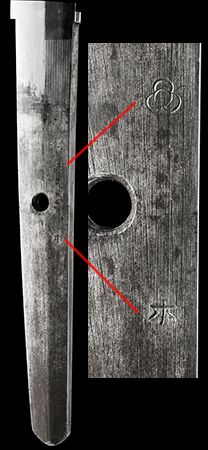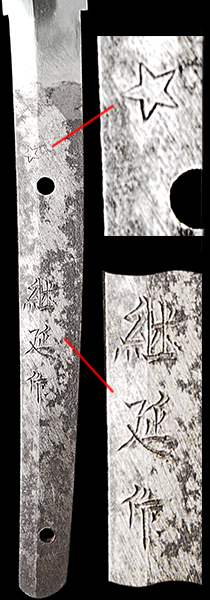�R����(4)�@�������@Army Arsenal blade0
�� �� ���@Army Arsenal blade
�������@�@Army Arsenal�@
�� �� ��
���R�����������ږ��͊ē����������Z�p���g�ɂ͓��ނ�����B����́A��ʓI�Ɂu�������v�ƒʏ̂���Ă����B
�� �� �b �B ��
�P. �e�H�� (������) �b�����Őꑮ���������Ɉ˂�쓁���ꂽ�b�B�� (�s�ɓ������Ƒ������W�͍���)
�@�@�����C���H��: ���R�S��E�X�����g�A������ꗤ�R������: �g����� (���A�E���Ɠ��l)�A���H��(������): ���R�叟�E���
�@�@(���) �E��d�E�����A���q�H��(������): �����q���F�E����d�E�����A�@�����폱�@�P���@��
�Q. ���ԓ������͓�����ЂɈϑ������b�B�� (�s�ɓ������Ɨ��R�f�ތ����̐�����)
�R. ���R��������b�B�� (�s�ɓ������ƔN�G�A���R�f�ތ����̐�����)
�@�@���R�������쓁���鐧�����g�@���a15�N���玎�s����A17�N����{�i�I�ɑS���W�J���ꂽ�B
�@�@�ʎ���œ��ꐫ�������A���\�ɑ傫�ȃo���c�L��������{�����u���S�K�i���v���鏉�߂Ă̎��݂������B
�@�@�꓁���ɑ�ό������������s�����\�i�����ۏ��ꂽ�B
�@�@�ߋ��A�Í쓁�̖����ƌ�������̂ł����\�����ꂽ���̂͂Ȃ��B
�@�@�w(�قƂ�)�ǂ������`���ł���A������͐��\�ۏƂ͂Ȃ�Ȃ��B
�@�@���������ʂł͈�̉���ł������B�u�����v�K�i���Q��
�� �Y ��
�P�D�������� (�R�l��ٌď�)�@
�@�@��ʑ��̂́u�������v�B��ꎮ���m�p�� (���a6�`7�N) ���n�܂�ŁA���̓��A���Z�ɔ̔����ꂽ���̂��w���B
�@�@��̋�����g����܂���B�u�������ō��ꂽ���g�v�Ƃ����Ӗ��̒ʏ̂ł���B�X�ケ�̎s�̕i��O���������Ƃ��Ă����B
�@�@�u���R�����| (C1.0%-1.1%) ���g�p���A�������[���y�ы@�B�n���}�[���ɂ��b�����^�B
�@�@���@�A�d�ʂ́A�������m���p��������������c�y�ʂōאg�B
�@�@���ē��������̂����������ɂ��@�B�d�グ�������B�n�������v (����������z�L���) �B
�@�@���^�͎O�\��N�����m�����B�{�����m���������A���Z�p���g�̕s���A�b�B���̔Y����₤�ׁA���B�`��C���ς��u������
�@�@���a6�`7�N�����珫�Z�ɔ̔����ꂽ��1�B�@�@�@�@�@�@�@�@�@�@�@�@�@�@�@�@�@�@�@��1 ���̓��g�]���́u���퓁杁E���g�]���v�Q��
�Q�D�������@�ŗL������
�@�@��L���R��������b�B���Ɠ��l�ɁA���a13�N9��16���t��������ܘZ�Z���j�ʒB�̐V�R�����얽�߂����_�ł���B
�@�@���a14�N5���A���q���R�������́A�ʍ|�Ɠ����|���g�p�������쓁�g�̑������ʂ��u�����b��v�Ɍf�ڂ����B
�@�@���̌�17�N�����̑�5��Ɏ�����A�e��|�ނƍ쓁�@�̎���Ǝ������J��Ԃ���Ă���B
�@�@���̌�̜b��Ɍf�ژ_�e�������ׂɁA�ŏI�Ă͊ւŏ��a16�N�ɊJ�����ꂽ�u�Î����b�B���v�Ƌߎ������ʍ|(����)���@�B�b�B��
�@�@�����g�Ɛ��@���Ă��邪�A���É����R�������֕��H�꒷�E���������̉�z�L�ɂ�
�@�@�u�`�@���T�˒b�B���ɏ��������̂ŁA���g�͗��R�����|��2 (C1.0%-1.1%) ���g�p�B�@�@�@�@�@��2 �u����R���v�̓��g���Q��
�@�@�Α���f���א��`���Ĕ����t�����ē�(840��)�A�Ė�(530��)�B�b�B���ɏ����ď㌤���B
�@�@���ē���̂��ߐ܂�Ȃ����A�n�������B�����̊J�n���x�������B���v�ɉ�����ꂸ�v�Əq�ׂĂ���B
�@�@���a16�N���߁A�u�a�|��b�B����×��̓��{�����ɋ@�B�͂𗘗p���Ď���v�Ƃ̕���3�Ƃ͈���Ă���B
�@�@���ނ����R�����|�ł���A���̐��������ł́A�����ȊO�ɋ���Ƃ̌���I�ȍ����͂߂Ȃ��B�@�@�@�@�@�@�@�@��3 �V�R�������Q���@
�@�@���q���R���������������琧���ʎY���J�n�������̓����͔���Ȃ����A���a18�N���疼�É����R�������֕��H��ł͒��ڐ�����
�@�@���A�֓����i���j��17�Ђ����͂��Đ������J�n���� (�֎j���)�B�ֈȊO�ł́A�����̕����R����
���i���j������������B
�@�@���ԉ�����Ђ̑������X���Ƃ��āi�L�j���i�Ђ́u�`���A���A�`���A�����v�A�����R�������i���j�́u�����v�������R�X��
�@�@�W�Ŋm�F����Ă���B
�@�@���A���q���R�������̏����Ƃ��ĐV�R���J���Ɋ֗^������B���E�J��������4�́A�u���{���̖���w�I�����v(1981�N�u�S�ƍ|�v)
�@�@�ŁA�u���a15�N������펞�F���Z���ƂȂ�A���̍��A���q���R�������ł͏��Z�p�R���̎��v�ɉ����ׂ��A�̂Ɠ����̓��{������
�@�@���n�߂��B���H���̑��c�Ɏ��Z�p�����́A��B���œ����b�B��@���Q�l�Ƃ��A�����ɂ͂����琁���̋ʍ|��p���A�b�B�ɂ͋@
�@�@�B�n���}�[���g���Ė{���I���{���̗ʎY�̖ړI���ʂ����A��r�I��R�X�g�ŏ��Z�R�����o�����B���́u���a�V���v�͎��p�I���\
�@�@�͌×��̓��{���ɗ��Ȃ��ƍl�����邪�A�|�p�I�ɂ�ꡂ��ɋy�Ȃ��v�Əq�ׂĂ���B
�@�@�����̎�������A���̑������͗��R�����|�̈ꖇ�b���Ƃ͍l����̂����A�����҂Ƃ��Ă̔��������̌��t���d���B
�@�@�����������́A������b(����)���������ꂽ���ƁA�푈�����̕��ƂňႢ���������悤�Ɏv����B
�����^����������Ȃ��B
�@�@�X�ケ�̓��g������������ƌď̂��Ă����B����ɂ���ʎY�̐��̊m���͗]��ɂ��x�������B
���������ڐ����̌s�ɂ͑������W�͂ƌ���������B
���Ԋ�ƂŐ��삳�ꂽ�������̓������͈ꕔ�m�F����Ă��邪�A���g�������m�F����Ă��Ȃ��ׁA�s�̖��ƍ���͕s���ł���B
���q���R�������͐V�R��(���������)�����삷��i�K�ŁA�J���X(�Ђ��)��B��勳���̎w�������A
�@�B�n���}�[�Ɉ˂�����I�Ȑ���
���@���m��������5�B
�������Ɠ��l�ɁA���a12�N����15�N�ɂ����āu���S�E������S���v�A�u�U�����v�A�u�Q�����v�ȂǁA�Ȋw�̗͂����p���ē��{����(��
��)���D�G�ȌR���g���������Ă����B�����͑��ėʎY�ݔ���O��Ƃ������g�ł���B�@�@�@�@�@�@�@�@�@�@��5 ���Z�p�R���̌����Q��
���a16�N�A��������������ł����{���Î��b�B�̋@�B���ɐ��������B����́u�Î����b�B���v�Ə̂���A���i�ɂ͌����������
��݂��A�u�ցv�A��ɓ����ȗ߂Ɉ˂�u���̒��ɏ��v�����ē��̕i����ۏ����B
�R�������̎��ǂ��Âɔ��f���Ă���A�����D�G�ȗʎY�������g�𐳓��ɕ]�����Đ����𑁊��Ɋ����͂ɐ��i���ׂ��ł������B
���{���_�b�ɐ��܂��������E�̌R������A�ꕔ�̌R�W�ҒB�ɂ���ėD�G�ȗʎY�R���̐��������ʂƂ��đj�Q���ꂽ�B
���ǂ̔��f����o���Ȃ��y�Ɉ˂��āA�[���ȌR���s���������A�R�������傫����点�Ă��܂����B�@�@ �u�R���s���Ƒ������v�Q���@
�@�@�@�@�@�@�@�@�@�@�@�@�@�@�@�@�@�@�@�@�@�@�@�@�@�@�@�@�@�@�@�@�@�@�@�@�@�@�@�@�@�@�@�@�@�@�@�@�@�@�@�@
�@�@�@�@�@�@�@�@�@�@�@�@�@�@�@�@�@�@�@�@�@
��4 �J���X: �������H�w���U���ꔎ�m�̋����q�B
�@�@�@�@�@�@�@�@�@�@�@�@�@�@�@�@�@�@�@�@�@�@�@���a11�N�����B���̓��{���b�B���Ŋe�n�̓������������{���̐���H�������w�I�Ɍ�������
1
�� �� �� �� ��
The blade considered to be formality
Zohei-to.
�n��: 68.1�p�A����: 1.7�p�A�n���̓G�b�`���O�ł���ꂽ���̂Ǝv����
�Ε\�n�o�L�t���S�i�A�����蓁�g
��ʓI�ɁA�������ő���ꂽ���Z�p���g�s�ɂ́u�������W�́v�̍��A���Ԃɐ����ϑ����đ������ɔ[�����ꂽ���g�s�ɂ�
�u���R���́v�������ō����ꂽ(�����Q��)�B
Generally, a "arsenal trademark" is stamped on the swod-tang
forged with the arsenal. And the "army star" was stamped
on the swod-tang which carried out outsourced manufacturing to the
private sector.
����Ɠ���̓��g�͍����O��4�Ⴊ�m�F����Ă���B�㔪���O���Ɏ��߂��A���̊O���͑��ĕ��T�C�g�f�ڗ�Ɠ���i�ł��B
�O���t���̑������������L�̕��͂��A�����������B
�Ε\ �ؐ摤�ƌs�����i
�@
�Ε\ �ؐ�Ɠ��g�����̕���

�Η����g�S�i�@�@�������W���ƌ�����͘Η��̌s
�Η��̐ؐ摤�ƌs�����i(������̌s�ɑ������W���ƌ�����)
�Η��̐ؐ�Ɠ��g�����̕���
�@�@�@�@�@�@�@�@ �@�@ �@�@
|
�@�@�@
���@�l�̖C�e�}�[�N
���q(����)�������W�� (�������W���͂�����)
Kokura Army Arsenal mark
���@�u�z�v�͑�ꐻ����������
"Ho" is First Factory inspection marks.
�u�Z�v�͑����������
"Se" is Second Factory inspection marks.
�����ő���ꂽ�������͑�ꐻ�����ő���ꂽ���g�Ƃ̐n���Ɣ��肪�قȂ�A
���Ɍs�̒����ɑ傫�ȍ�������B��̒����������ɈႤ�B
���̍������������Ɉ˂���̂��A���������ɑ��Ⴊ�������̂��͕s���B
��̐������̓��g���͉��ʐ^���Q�Ƃ��ꂽ���B
|
(�f�ڐ���������: Y.������ ����)
�������̐������A���͐��������ɂ�鍷
�@�@�@�@�@��ʐ^: ���q(����)��������ꐻ����(������u�z�v)
�@�@�@�@�@�@�@�@�@�@�@�@�n��: 68.1�p�A����: 1.7�p�A
�@�@�@�@�@���ʐ^: ���q(����)�����������(������u�Z�v)�@�t�B�������hMr.Ronny Ronnqvist�B�e�̓��g(������)
�@�@�@�@�@�@�@�@�@�@�@�@�@�n��: 65.0�p�E����: 1.65�p
�n���Ɣ��肪�Ⴂ�A���Ɍs�̌`��ƒ����Ɍ����ȍ�������B
�u�z�v����̓��g�s���� 15.8�p�A����R���g�A�O���R���g�̌s�ɔ�ׂĂ����Ȃ�Z���B
��̎n�_�A�I�_�̌`��Ⓑ���ɂ������ȑ��Ⴊ����A���g����p���b�g�̌`�����̂܂ܔ��f���Ă���B
���R�����������ԓ��H�Ɉϑ����đ��点�����Z�p�̓��g
The blade for officers which the Army
Arsenal entrusted to the private sector swordsmith
���R�O�������^�O���ɔ[�߂�ꂽ���ԓ����̓��g
�������ɔ[�߂�ꂽ�p�������̓��g
�@�@�@�@�@
|
�� ���R����
�O���ϑ��i�ɓK�p����⏕����
��Ƃ��đf�ތ����ɗp�����A������ɏ�����
�e�W�����ʂƂ���
�� �Q���E�p�����쓁���đ������ɔ[�߂�ꂽ���g�B
�@�@�������̊�ɍ����Ă�����i�̈�Ƃ��ė��R���͂�
�@�@�s�ɑō����ꂽ�B
�@�@�@�@�@�@�@�@�@�@�@�@(�R���ɖ�������)
|
The blade for officers made from an
Army Arsenal
There are two kinds of blades for officers of directly or
supervisor manufacture on an army arsenal. In the public,
the common name was carried out to "Zōhei-tō.
Forging
sword
1. Forging sword in which swordsmith under exclusive contract carried
out sword making by sword workshop of each
�@arsenal (A swod-tang has a swordsmith Mei and an arsenal
trademark stamp)
�@Osaka Arsenal:
Gassan Sadakatsu, Masakiyo, Kokura Arsenal: Hakuryushi Tadataka,
Tairano Sadashige, and Kanenobu,
�@Arsenal:
Yoshihira others.
2. Forging sword entrusted to private sector swordsmith or sword
company (A swod-tang has a swordsmith Mei and an
�@inspection mark "star" of an arsenal).
3. Army formality present age forging sword (A swod-tang has an
inspection mark "star" of an arsenal, swordsmith Mei
�@and production years).
�@The formality blade which the army commission swordsmith
made. It is trial production blade completion to the end
�@of 1940.
�@The whole country was completely developed from 1942. It was the
first trial that carries out full standardization
�@of the Japanese sword which does not have unity individual handmade
and had a big gap also in the performance.
�@Very severe inspection was conducted for every sword, and
performance quality was guaranteed.
Mass-production
blade
1. Common name "Zōhei-tō."
�@The Type 91 noncommissioned officer blade sold to the
officer will be said around 1931-2.he next Type 95 blade is
�@also included. The common name of the meaning "the blade
made from the arsenal."Army sword steel (C1.0%-1.1%) is
�@used.
�@One-sheet forging. It is forge molding by the rolling
roll, a machine hammer, etc. The size and weight of this blade
�@are slightly lightweight and a thin figure compared with
"formality Zohei-to." The tempering in oil of this blade
�@was carried out, and it carried out machine finish by dry
polish. There is no tempered line (account of Major Bitō
�@recollection).
2. Zōhei-tō (Peculiar formality name)
�@The manufacture command of the new military swords as of
September 16, 1938 is the starting point like the
�@bovementioned army formality present age forging sword.
�@The trial production blade was completed by the end of
1940 by the Kokura Army Arsenal. It is imagined as "the
�@ancient rite half forging sword of a Tamahagane" developed
behind in Seki, and the approximated blade.However,
�@Major Bitō's (Nagoya Army Arsenal Seki Part Factory
manager) account of recollection is as follows.
�@"The shape and the size applied to the forging sword
correspondingly in general. A blade uses army sword steel
�@(C1.0%-1.1%).
�@Fire structure one-piece-no-forging fabrication was
carried out. And curvature was attached and a tempering in oil
�@(840 degree Centigrade) and tempering were returned (530
degrees). According to the forging sword, it polished
�@good.
�@Although it does not break for a tempering in oil, there
is no tempered line(Hamon).The end of 1940 and the report
�@"the Kokura army arsenal made the blade as an experiment
to the Japanese sword from ancient times which forges a
�@Tamahagane using mechanical power" are differed from.
Sword material is also army sword steel and cannot hold a
�@decisive difference with Type 95 only by this explanation
other than a polish.
�@The time of from when the Kokura Army Arsenal started
formality mass production is not known. In 1943, in the
�@Nagoya Army Arsenal Seki Part Factory, 17 companies, such as Seki
sword Inc, besides direct manufacture,
�@cooperated, and manufacture was started at it (history of Seki). In Kantō,
Hattori Guntō Seizō Inc, in Tōkyō is
�@also checked.
�@As private Zōhei-tō's swordsmith, of "Yoshimasa,
Kaneshige, Yoshitada, and Kanemasa"of Kyōshinsha limited Co. and
�@"Yorimasa"of Hattori Guntō Seizō Inc etc, is checked. They
are a commission swordsmith or a swordsmith. Also from
�@this thing, it is hard to consider this Zohei-to to be a
blade of an army sword steel one-sheet forging.
�@However, the meaning of description of the account of
recollection of Major Bito as the party concerned is heavy.
2013�N9��17�����
�y�[�W�̃g�b�v����








 �@�@
�@�@



